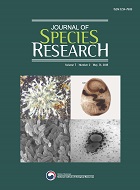- Apply for Authority
- KOREAN
- E-ISSN2713-8615
- KCI
 E-ISSN : 2713-8615
E-ISSN : 2713-8615
Report of 21 unrecorded bacterial species in Korea belonging to the phylum Actinobacteria, discovered during the survey in 2020
Ji Won Jeong
Im Wan-Taek
Kim Wonyong
YOON, JUNG HOON
Myung Kyum Kim
Chi-Nam Seong
Seung Bum Kim
- Downloaded
- Viewed
Abstract
The phylum Actinobacteria includes many groups of aerobic, Gram-stain-positive, rod, or filamentous shaped bacteria. Actinobacteria are known for multicellular differentiation in some groups, and also for production of various secondary metabolites such as antibiotics. During a series of extensive surveys of indigenous prokaryotic species diversity in Korea, bacterial strains belonging to Actinobacteria were isolated from various sources of terrestrial environments. A total of 21 bacterial strains, belonging to 10 genera in 8 families, were isolated as unrecorded species in Korea. Among them, 11 were assigned to the family Streptomycetaceae, two species assigned to each of the families Microbacteriaceae, Mycobacteriaceae and Nocardioidaceae, and one species assigned to each of the families Euzebyaceae, Corynebacteriaceae, Micrococcaceae and Intrasporangiaceae. At the genus level, Streptomyces (10 species) was the most abundant, followed by Microbacterium and Mycolicibacterium (2 species each), and one species in each of the genera Corynebacterium, Euzebya, Arthrobacter, Terracoccus, Kribbella, Nocardioides and Yinghuangia. The detailed descriptions of each unrecorded species are provided.
- keywords
- Actinobacteria, Streptomyces, unrecorded species
Reference
Amin, D.H., N.A. Abdallah, A. Abolmaaty, S. Tolba and E.M. Wellington. 2020. Microbiological and molecular insights on rare Actinobacteria harboring bioactive prospective. Bull. Natl. Res. Cent. 44:1-12.
Felsenstein, J. 1985. Confidence limits on phylogenies: an approach using the bootstrap. Evolution 39:783-791.
Goodfellow, M., P. Kämpfer, H.J. Busse, M.E. Trujillo, K.I. Suzuki, W. Ludwig and W.B. Whitman. 2012. Bergey’s Manual of Systematic Bacteriology, 2nd edition, vol. 5, The Actinobacteria. Springer, New York.
Jeon, Y.S., K. Lee, S.C. Park, B.S. Kim, Y.J. Cho, S.M. Ha and J. Chun. 2014. EzEditor: a versatile sequence alignment editor for both rRNA- and protein-coding genes. Int. J. Syst. Evol. Microbiol. 64:689-691.
Jukes, T. and C. Cantor. 1969. Evolution of protein molecules. In: H.N. Munro (ed.), Mammalian Protein Metabolism, Academic Press, New York. pp. 21-132.
Kim, M.S., S.B. Kim, C.J. Cha, W.T. Im, W.Y. Kim, M.K. Kim, H. Yi, H.R. Kim and C.N. Seong. 2021. Description of unrecorded bacterial species belonging to the phylum Actinobacteria in Korea. J. Species Res. 10:23-45.
Kim, O.S., Y.J. Cho, K. Lee, S.H. Yoon, M. Kim, H. Na, S.C. Park, Y.S. Jeon, J.H. Lee, H. Yi, S. Won and J. Chun. 2012. Introducing EzTaxon-e: a prokaryotic 16S rRNA gene sequence database with phylotypes that represent uncultured species. Int. J. Syst. Evol. Microbiol. 62:716-721.
Kumar, S., G. Stecher and K. Tamura. 2016. MEGA7: Molecular Evolutionary Genetics Analysis version 7.0 for bigger datasets. Mol. Biol. Evol. 33:1870-1874.
Naikpatil, S.V. and J.L. Rathod. 2011. Selective isolation and antimicrobial activity of rare actinomycetes from mangrove sediment of Karwar. J. Ecobiotechnol. 3:48-53.
Saitou, N. and M. Nei. 1987. The neighbor-joining method: a new method for reconstructing phylogenetic trees. Mol. Biol. Evol. 4:406-425.
- Downloaded
- Viewed
- 0KCI Citations
- 0WOS Citations

